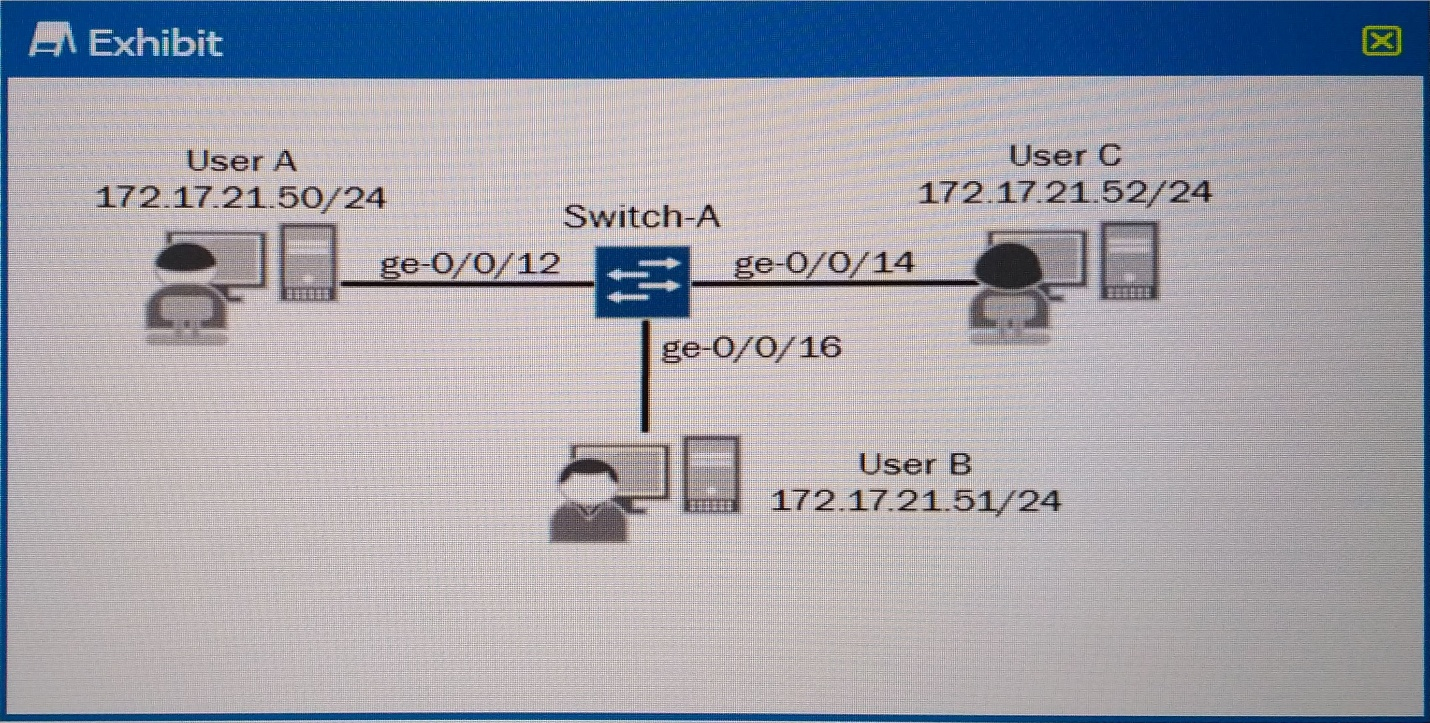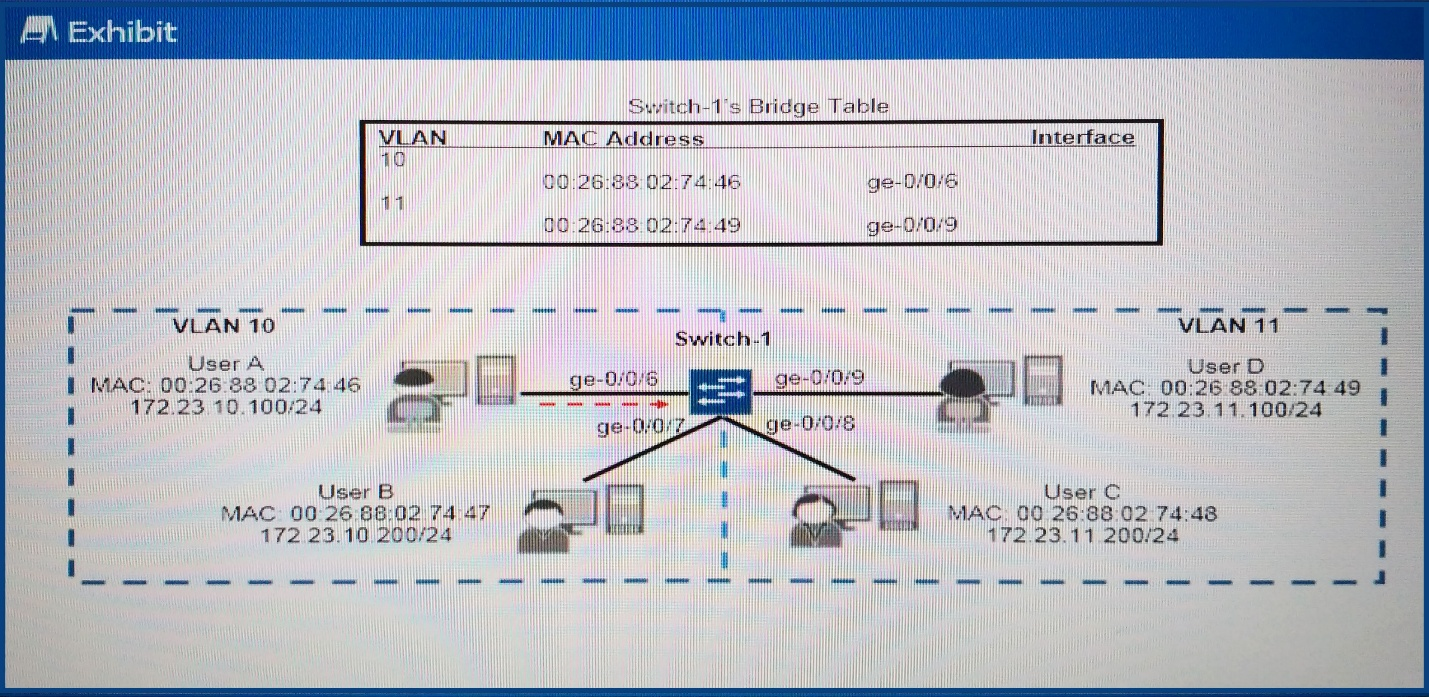Which mechanism is used to share routes between routing tables?
- A. filter-based forwarding
- B. forwarding instances
- C. RIB groups
- D. routing instances
Answer : C
Explanation:
A RIB group is a way to have a routing protocol, in most cases, place information in multiple route tables.

Click the Exhibit button.
A routing table contains multiple BGP routes to the same destination prefix. The route preference is the same for each route.
Referring to the exhibit, which route would be selected?
- A. route A
- B. route D
- C. route B
- D. route C
Answer : C
Explanation:
Route B with the highest local preference is preferred. See step 3 below.
Understanding BGP Path Selection
The algorithm for determining the active route is as follows:
References:
https://www.juniper.net/documentation/en_US/junos12.3/topics/reference/general/routing- ptotocols-address-representation.html

Click the Exhibit button.
In the exhibit, each IP subnet in the campus environment is associated with a unique VLAN
ID.
Which action will ensure that Host C will communicate with Host A and Host B?
- A. Configure an IRB interface for each VLAN and associate it with its corresponding VLAN.
- B. Configure all switch ports connecting to the host devices as trunk ports associated with all VLANs.
- C. Configure a port-based ACL that permits inter-VLAN routing for all configured VLANs.
- D. Configure all switch ports connecting to the host devices as access ports associated with a common VLAN.
Answer : A
Explanation:
Configuring Routing Between VLANs on One Switch
To segment traffic on a LAN into separate broadcast domains, you create separate virtual
LANs (VLANs).
Of course, you also want to allow these employees to communicate with people and resources in other VLANs. To forward packets between VLANs you normally you need a router that connects the VLANs. However, you can accomplish this on a Juniper Networks switch without usinga router by configuring an integrated routing and bridging (IRB) interface (also known as a routed VLAN interfaceor RVIin versions of Junos OS that do not support Enhanced Layer 2 Software).
References: http://www.juniper.net/documentation/en_US/junos15.1/topics/example/RVIs- qfx-series-example1.html

Click the Exhibit button.
Given the configuration shown in the exhibit, what will be the threshold for storm control?
- A. 100 Kbps (kilobits per second)
- B. 100 Mbps (megabits per second)
- C. 100% (percent of link bandwidth)
- D. 100 pps (packets per second)
Answer : A
Explanation:
This example shows how to configure the storm control level on interface ge-0/0/0 by setting the level to a traffic rate of 15,000 Kbps, based on the traffic rate of the combined applicable traffic streams.
To configure storm control:
Specify the traffic rate in Kbps of the combined traffic streams on a specific interface:
[edit ethernet-switching-options]
user@switch# set storm-control interface ge-0/0/0 bandwidth 15000
References: https://www.juniper.net/techpubs/en_US/junos12.3/topics/example/rate- limiting-storm-control-configuring.html#X7AlwRyc817gtLBC.99

Switch-1 in the exhibit receives a packet from User A with a destination MAC address of
00:26:88:02:74:47.
Which statement is correct in this scenario?
- A. Switch-1 floods the packet out ge-0/0/6, ge-0/0/7, ge-0/0/8, and ge-0/0/9.
- B. Switch-1 floods the packet out ge-0/0/7 and ge-0/0/8.
- C. Switch-1 floods the packet out ge-0/0/7, ge-0/0/8, and ge-0/0/9.
- D. Switch-1 sends the packet out ge-0/0/7 only.
Answer : C
Explanation:
To forward a frame destined to that specific mac-address, it will know out of which port to send the frame.
Flooding however occurs when the switch does not know of the destination mac-address say the switch has not learnt that mac address yet; or maybe that specific entry expired so it got flushed away from the mac-address table. To ensure the frame reaches its intended destination, the switch will replicate that frame out of all ports, less the port where the frame was received thats flooding.
References:http://blogbt.net/index.php/2015/03/mac-address-table-arp-table-and-unicast- flooding-part-i/

